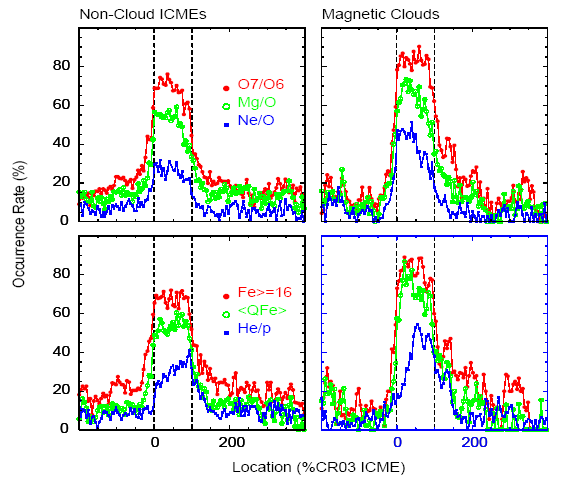
| ACE News Archives | ACE News #84 - Oct 27, 2004 |
Subscribe to ACE News |

Coronal mass ejections hurl large volumes of magnetized plasma into interplanetary space, often referred to as "interplanetary coronal mass ejections (ICMEs) or "ejecta". ICMEs are important components of the solar wind; they can cause enhanced geomagnetic activity when they encounter the Earth's magnetosphere. A subset of ICMEs with strong, organized, flux-rope-like magnetic fields are known as magnetic clouds.
Richardson and Cane have recently examined the use of plasma composition data from the SWICS and SWEPAM instruments on ACE for "routine" identification of ICMEs. Previous studies have shown that ICMEs tend to be associated with compositional and charge state anomalies e.g. enhanced charge states of iron and oxygen. Hourly-averages of O7/O6, Mg/O, Ne/O and iron charge states derived from SWICs were examined. Their dependence on solar wind speed in normal solar wind was first characterized; these parameters are all anti-correlated with solar wind speed. Then intervals of "anomalous" composition were identified by comparing each hourly-averaged value observed by SWICS with the "expected" value for normal solar wind with the same speed. Previous studies have typically used fixed criteria (e.g., O7/O6 > 0.8) to identify anomalous values. The intervals identified had an excellent association with the ~200 ICMEs identified in a previous study by Cane and Richardson (CR03) using plasma bulk parameters and magnetic field observations. A similar result was found when identifying periods of enhanced He/H ratio (>6%) with SWEPAM.
The figure above summarizes one aspect of the relationship between the ICMEs identified by CR03 and compositional anomalies. It shows the occurrence rates of anomalously enhanced values of O7/O6, Mg/O, Ne/O, the fraction of Fe ions with charge states >= 16, the mean Fe charge, and He/H >= 0.06, for all the ICMEs as a function of location with respect to the CR03 ICME boundaries (0%=ICME leading edge; 100%=ICME trailing edge). Note that the ICME boundaries order the compositional anomalies rather well, confirming the association between ICMEs and compositional anomalies. For enhanced oxygen and iron charge states, anomaly rates are >~70%, suggesting that they provide a rather common signature of ICME material. Other signatures have lower occurrence rates. The anomaly rates tend to be higher for magnetic clouds than for non-cloud ICMEs.
We conclude that plasma composition data provides valuable insight into the presence of ICMEs in the solar wind, and should be routinely incorporated into efforts to identify and study such structures, complementing methods based on plasma bulk parameters, magnetic fields, and other data.
Contributed by Ian Richardson and Hilary Cane (NASA/Goddard Space Flight Center), and Thomas Zurbuchen (University of Michigan). Questions or comments can be addressed to richardson@lheavx.gsfc.nasa.gov.
Last modified 27 Oct 2004, by